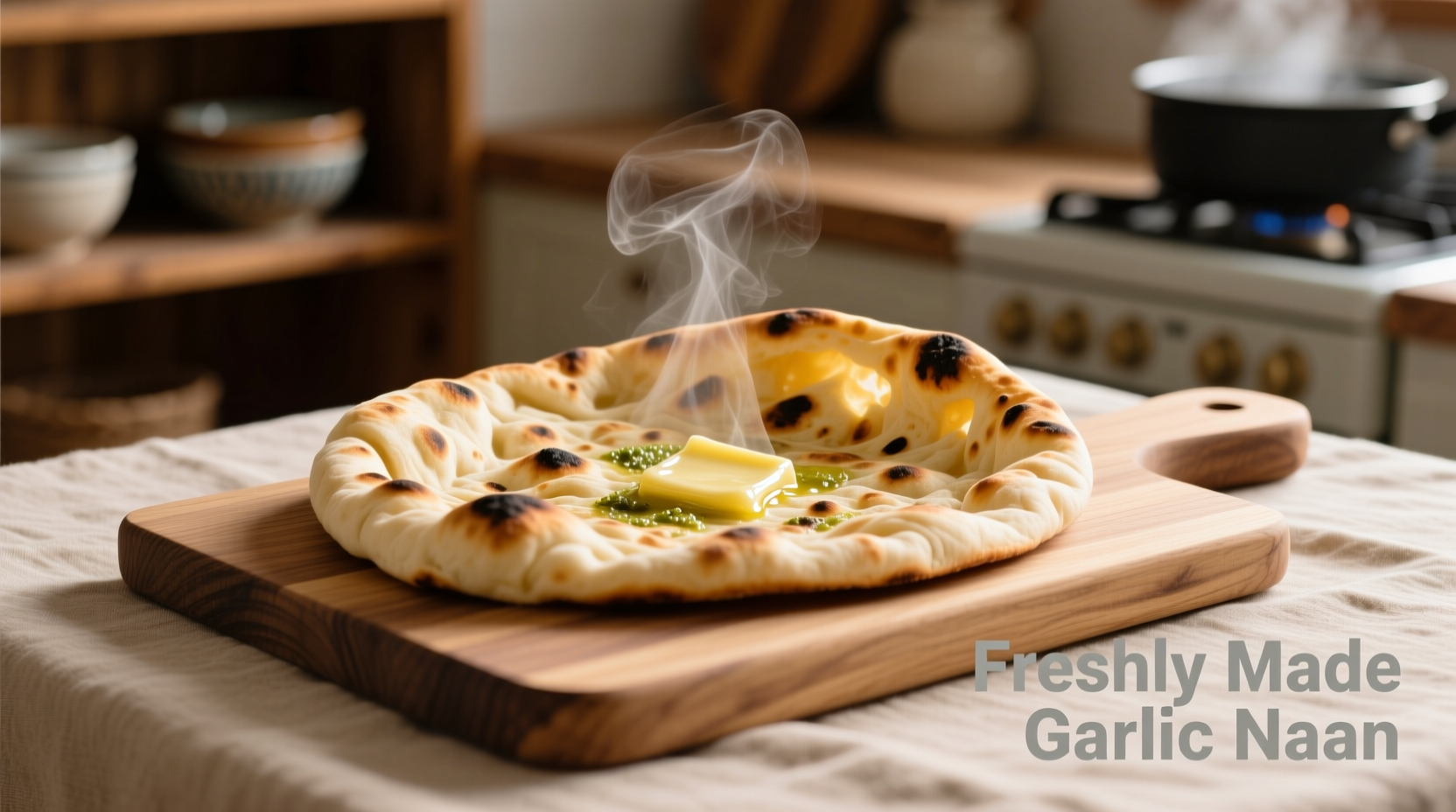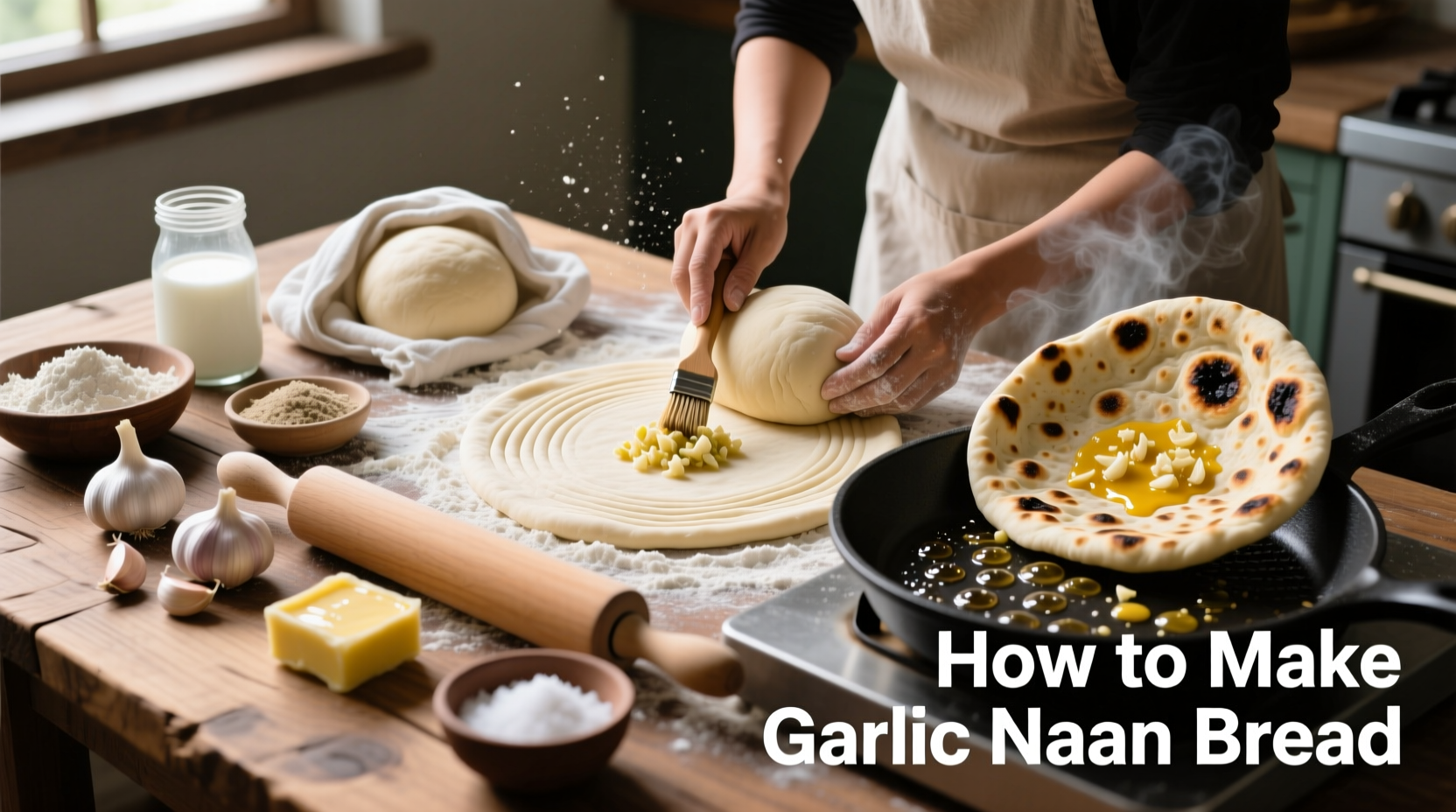Mastering Homemade Garlic Naan: Your Complete Guide
Craving that soft, pillowy garlic naan with perfect char spots from your favorite Indian restaurant? You can achieve professional results at home with the right technique. This guide breaks down the authentic preparation method used by chefs, focusing on the critical factors that transform basic ingredients into extraordinary bread.Essential Ingredients for Authentic Flavor
The magic of garlic naan comes from just a handful of quality ingredients. Don't skip the yogurt - it's crucial for tender texture:- All-purpose flour (3 cups) - bread flour works for chewier texture
- Active dry yeast (2¼ tsp) - or 1 packet
- Warm water (¾ cup) - 105-110°F
- Plain yogurt (¼ cup) - full fat for best results
- Sugar (1 tsp) - activates yeast
- Salt (1½ tsp)
- Unsalted butter (4 tbsp) - for finishing
- Fresh garlic (4 cloves) - minced fine
- Chopped cilantro (2 tbsp) - optional garnish
| Ingredient Variation | Traditional Approach | Modern Home Kitchen Adaptation |
|---|---|---|
| Flour Type | Maida (refined wheat) | All-purpose or bread flour |
| Cooking Surface | Tandoor (clay oven) | Cast-iron skillet or pizza stone |
| Garlic Application | Raw garlic paste before cooking | Fresh garlic butter after cooking |
| Leavening | Natural fermentation | Yeast + baking powder boost |
Equipment You'll Need
- Large mixing bowl
- Stand mixer with dough hook (optional but helpful)
- Rolling pin
- Cast-iron skillet or heavy-bottomed pan
- Pastry brush
- Kitchen towel
Step-by-Step Preparation Process
Dough Development: The Foundation of Perfect Naan
- Activate the yeast: Combine warm water, sugar, and yeast in a small bowl. Let sit 5-10 minutes until foamy.
- Mix dry ingredients: Whisk flour and salt in a large bowl.
- Combine wet ingredients: Add activated yeast mixture and yogurt to dry ingredients.
- Knead to windowpane stage: Mix 8-10 minutes until smooth and elastic. Properly developed dough should stretch thin without tearing.
- First rise: Place in oiled bowl, cover with damp cloth, and let rise 1-1.5 hours until doubled.
Garlic Butter Preparation
While dough rises, prepare the garlic butter that gives naan its signature flavor:- Melt butter in small saucepan over low heat
- Add minced garlic and sauté 1-2 minutes until fragrant but not browned
- Remove from heat and stir in chopped cilantro if using
- Keep warm but don't let garlic burn - this destroys flavor compounds
Shaping and Cooking Technique
- Divide dough: Punch down risen dough and divide into 6-8 equal balls.
- Roll carefully: On lightly floured surface, roll each ball into 6-7 inch oval, about ¼ inch thick. Traditional naan is unevenly rolled for varied texture.
- Preheat cooking surface: Heat cast-iron skillet over medium-high heat for 5 minutes until very hot.
- Cook naan: Place rolled dough on hot skillet. Cook 1-2 minutes until bubbles form and bottom has char spots.
- Flip and finish: Flip and cook 30-60 seconds until second side has light char. For extra puff, hold briefly over open flame.
- Apply garlic butter: Immediately brush cooked side with garlic butter mixture.

Avoid These Common Mistakes
- Over-flouring while rolling: Creates tough, dry naan. Use minimal flour just to prevent sticking.
- Cooking at too low temperature: Results in pale, dense bread without characteristic bubbles. Skillet must be properly preheated.
- Burning the garlic: Burnt garlic turns bitter. Sauté just until fragrant.
- Applying butter before cooking: Causes burning and uneven cooking. Always apply after cooking.
Historical Context of Naan Bread
Naan's evolution reflects centuries of culinary adaptation across South Asia. Originally developed in Mughal-era India around the 16th century, traditional naan was baked in tandoor ovens using maida flour. The introduction of garlic naan came later as regional variations emerged. According to culinary historians at the University of Delhi's Department of Food Studies, garlic naan became popular in North Indian restaurants during the 1970s as chefs experimented with Western flavor preferences while maintaining traditional techniques (University of Delhi Food Studies).Serving and Storage Tips
- Serve immediately for best texture - naan is at its peak within 5 minutes of cooking
- Pair with creamy curries like butter chicken or palak paneer
- Store leftovers in airtight container for up to 2 days
- Reheat in dry skillet over medium heat 30 seconds per side
- Freeze cooked naan between parchment paper for up to 3 months
Frequently Asked Questions
Can I make garlic naan without a yeast starter?
Yes, you can use baking powder as a quick alternative. Replace yeast with 1½ tsp baking powder and ½ tsp baking soda. Mix with dry ingredients, then add warm milk instead of water. The texture will be slightly different - less chewy and more biscuit-like - but still delicious. This method works well when you need naan quickly without waiting for dough to rise.
Why isn't my naan puffing properly?
Several factors affect puffing: 1) Dough hydration too low (aim for 70-75%) 2) Skillet not hot enough (should sizzle immediately) 3) Rolling too thick (¼ inch max) 4) Over-kneading after first rise. For best results, ensure your cooking surface reaches at least 450°F before adding dough. Professional chefs often flip naan when large bubbles form, then hold it briefly over open flame to encourage full puffing.
Can I make garlic naan gluten-free?
Traditional naan requires gluten for its characteristic texture, but you can create acceptable gluten-free versions using a blend of rice flour, tapioca starch, and xanthan gum. The texture will be more cracker-like than pillowy. For best results, add 1 tsp xanthan gum per cup of gluten-free flour blend and increase yogurt to ⅓ cup for better elasticity. Expect a denser final product that won't puff as dramatically.
How do restaurants get those perfect char spots on naan?
Restaurant-quality char comes from extremely high heat (700°F+ in traditional tandoors). At home, preheat your cast-iron skillet for 5-7 minutes over medium-high heat. The skillet should be hot enough that a drop of water sizzles and evaporates instantly. Don't flip too early - wait until large bubbles form and the bottom has dark char spots. Some chefs finish naan by holding it briefly over an open flame for dramatic charring.
What's the difference between garlic naan and regular naan?
Traditional plain naan contains only flour, water, yeast, and salt. Garlic naan adds fresh garlic and often cilantro to butter that's brushed on after cooking. Some variations include nigella seeds or black sesame seeds. Authentic garlic naan should have prominent fresh garlic flavor without bitterness - that's why the garlic is added after cooking rather than mixed into the dough. The texture remains identical to plain naan when prepared correctly.











 浙公网安备
33010002000092号
浙公网安备
33010002000092号 浙B2-20120091-4
浙B2-20120091-4